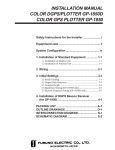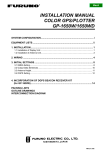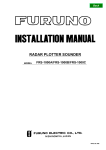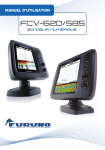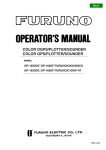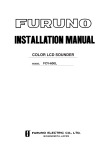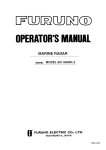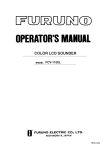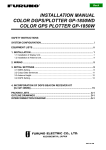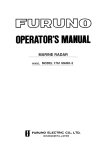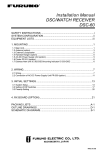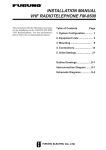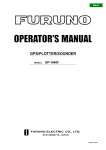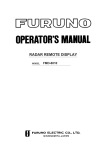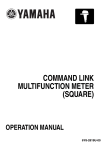Download Furuno GP-1850DF Marine GPS System User Manual
Transcript
INSTALLATION MANUAL COLOR DGPS/PLOTTER/SOUNDER GP-1850DF COLOR GPS/PLOTTER/SOUNDER GP-1850F Safety Instructions for the Installer ....................... i Equipment Lists ..................................................... ii System Configuration ........................................... iv 1. Installation of Standard Equipment ...............1-1 1.1 Installation of Display Unit .............................................. 1-1 1.2 Installation of Antenna Unit ............................................. 1-3 1.3 Installation of Transducers ............................................... 1-4 1.4 Installation of Sensors .................................................... 1-14 2. Wiring ...............................................................2-1 3. Initial Settings ..................................................3-1 3.1 NMEA Setting .................................................................. 3-1 3.2 Output Data Sentences ..................................................... 3-3 3.3 Antenna Height ................................................................. 3-4 3.4 Baud Rate Setting (GP-1850DF only) .............................. 3-4 3.5 Beacon frequency Setting (GP-1850DF only) ................. 3-5 3.6 Depth Adjustment ............................................................. 3-6 3.7 External Equipment Setup (Option) ................................. 3-7 3.8 Selecting the Echo Sounder Output Power .................... 3-10 4. Installation of DGPS Beacon Receiver (for GP-1850F) .................................................4-1 APPENDIX TRIDUCER 525ST-PWC/PWD ....... AP-1 PACKING LIST .................................................... A-1 OUTLINE DRAWINGS ......................................... D-1 INTERCONNECTION DIAGRAM ........................ S-1 SCHEMATIC DIAGRAM ...................................... S-2 C Yo u r L o c a l A g e n t/D e a le r 9-52, A shihara-cho, N ishinom iya, Japan Te l e p h o n e : Te l e f a x : 0 7 9 8 -6 5 -2 111 0798-65-4200 A ll rig h ts re s e rv e d . Printed in Japan PU B. N o. IM E-43950-J (H IM A ) G P -1850F/1850D F FIRST EDITIO N J : : FEB. N O V. 1999 01, 2001 SAFETY INSTRUCTIONS Safety Instructions for the Installer WARNING CAUTION Do not work inside the equipment unless totally familiar with electrical circuits. Ground the equipment to prevent electrical shock and mutual interference. Confirm that the power supply voltage is compatible with the voltage rating of the equipment. Hazardous voltage which can shock, burn or cause serious injury exists inside the equipment. Connection to the wrong power supply can cause fire or equipment damage. The voltage rating appears on the label at the rear of the display unit. Turn off the power at the mains switchboard before beginning the installation. Post a sign near the switch to indicate it should not be turned on while the equipment is being installed. Use the correct fuse. Use of a wrong fuse can cause fire or equipment damage. Fire, electrical shock or serious injury can result if the power is left on or is applied while the equipment is being installed. Keep the following compass safe distance. Standard Steering Display Unit 0.98 m 0.74 m When handling the transducer cable, keep in mind the following points. • Keep the cable away from oil and fuel. • Keep the cable away from the place where it may be damaged during the installation. • Do not paint the cable. The sheath of the transducer cable is made of chlorophrene rubber (or vinyl chloride). Therefore, do not paint the sheath with organic liquid (such as toluene) since it may harm the sheath. i i Equipment Lists Standard supply No. 1 2 3 Name Type Code No. Qty Remarks GP-1850F-E - 1 GP-1850DF-E - for GP-1850DF GPA-017 - for GP-1850F GPA-018 - GPA-019 - 520-5PSD 000-015-125 520-5PWD 000-015-126 520-5MSD 000-015-127 for GP-1850F Display unit Antenna unit Transducer 1 for GP-1850DF for GP-1850DF 1 for 600W output, select one. 4 Spare parts SP14-02501 004-375-260 1 Fuse 5 Installation materials CP14-05200 000-041-496 1 Power cable, Cable assy. FP14-02401 004-375-270 1 Hard cover FP14-02402 004-376-150 1 Screws, output mark label, rubber cushion 6 Accessories Optional equipment NO. 1 2 3 Name Type Remarks GPA-018, GR-7000A, whip antenna GR-802-1850-10A-018 000-041-498 GR-802-1850-10N-018 000-041-504 GPA-018, GR-7000A 000-041-499 GPA-018S, GR-7000A, whip antenna 000-041-505 GPA-018, GR-7000A GP-802-1850-10N-019 000-041-648 GPA-019, GR-7000A GR-902-1850-15N-019S 000-041-649 GPA-019S, GR-7000A TNC-PS-3D-15 000-133-670 15m, for antenna cable extension CP20-01700 004-372-110 30m, for antenna cable extension CP20-01710 004-372-120 50m, for antenna cable extension Beacon receiver GR-902-1850-15A-018S kit GR-802-1850-15N-018S Antenna cable assy. Code No. Antenna cable set 4 Cable Assy. MJ-A7SPF0003-050 000-136-730-01 5 Mast mount fixture CP20-0111 004-365-780 6 Right-angle antenna base No.13-QA330 000-803-239 7 L-angle antenna No.13-QA310 base 000-803-240 8 Antenna base No.13-RC5160 for rail mounting 000-806-114 ii for mounting antenna unit Optional equipment (con't) No. Name Type Code No. Remarks GPA-018S 000-041-462 for GP-1850DF GPA-016 000-041-536 for GP-1850F GPA-019S 000-041-554 for GP-1850DF 520-5PSD 000-015-125 for 600 W 520-5PWD 000-015-126 w/8m cable transom mount, for 600 W 520-5MSD 000-015-127 w/8m cable and water proof connector, for 600 W 50/200-1T 000-015-170 for 1 kW 11 Cable assy 02S4092 000-134-484 for 1 kW transducer connection 12 Matching box MB-1000 000-040-809 for 1 kW transducer connection ST-02MSB 000-137-986 Thru-hull type ST-02PSB 000-137-987 w/8m cable, thru-hull type No.13-QA330 000-803-240 for mounting antenna unit T-02MTB 000-040-026 T-02MSB 000-040-040 T-03MSB 000-040-027 524ST-MSD 000-015-224 525ST-MSD 000-015-263 520ST-PWD 000-015-128 525ST-PWD 000-015-261 02S4147 000-141-082 9 Antenna unit 10 Transducer 13 ST sensor 14 Inner hull kit S Temperature 15 sensor for 600 W 16 Triducer for 600 W 17 Converter connection 18 Rectifier 000-013-484 for 100VAC 000-013-485 for 110 VAC 000-013-486 for 220 VAC 000-013-487 for 230 VAC MJ-A6SPF0011-050 000-132-244 for connection radar, 6P-4P, 5m MJ-A6SPF0011-100 000-132-336 for connection radar, 6P-4P, 10m MJ-A6SPF0012-050 000-134-424 for navaid or E/S, 6P-6P, 5m MJ-A6SPF0012-100 000-133-817 for navaid or E/S, 6P-6P, 10m PR-62 19 Cable assy. 20 Whip antenna FAW-1.2 000-136-046 for GP-1850DF 21 Remote controller RMC-185F-E 004-375-320 Controller, vinyl cover, battery 00RAM02MC-004 004-371-790 2MB 22 RAM Card 23 DGPS Beacon Receiver GR-80 - iii for GP-1850F System Configuration The GP-1850F/1850DF mainly consists of a display unit, a GPS antenna and a dual frequency transducer. A DGPS beacon receiver is provided inside the display unit for GP-1850DF type. The mini chart card drive in the display unit loads electronic charts. External equipment which can be connected include water temperature and speed sensors, autopilot, and DGPS beacon receiver (GP-1850F). GPA-018 (for GP-1850DF) GPA-017 (for GP-1850F) 1.2 m Whip antenna (Option) GPA-019 (for GP-1850DF) ANTENNA UNIT Receives signal from GPS satellite and beacon reference station (GP-1850DF only). DISPLAY UNIT Ship’s position is calculated in longitude and latitude from signal received from the antenna unit and displayed on the screen. *Matching Box MB-1000 Ship’s mains 10.8—31.2 VDC External equipment (Autopilot, etc.) Temp. sensor (option) Transducer *Required for 1 kW transducer only iv DGPS beacon receiver GP-1850F only 1. Installation of Standard Equipment 1.1 Installation of Display Unit Mounting considerations The display unit can be installed on a tabletop, on the overhead or flush mounted in a console or panel. Hard Cover Tabletop Overhead Figure 1-1 Tabletop, overhead mounting methods When selecting a mounting location for the display unit keep the following in mind: • Keep the display unit out of direct sunlight. • The temperature and humidity should be moderate and stable. • Locate the unit away from exhaust pipes and vents. • The mounting location should be well ventilated. • Mount the unit where shock and vibration are minimal. • Keep the unit away electromagnetic field generating equipment such as motor, generator. • For maintenance and checking purposes, leave sufficient space at the sides and rear of the unit and leave slack in cables. • A magnetic compass will be affected if placed too close to the display unit. Observe the following compass safe distances to prevent disturbance to the magnetic compass: Standard compass: 0.98 meters Steering compass: 0.74 meters • Rubber cushions which absorb vibration (supplied) may be attached as below if vibration is a problem. Rubber cushion TM-166 No.18 black 45±5mm Aline with edge of hanger. 1-1 Mounting procedure Follow the procedure below to mount the display unit on a tabletop or the overhead. Tabletop, overhead mounting 1. Fix the hanger by four tapping screws M5 X 16. 2. Screw knob bolts in display unit, set it to hanger, and tighten knob bolts. 3. Attach hard cover to protect LCD. WARNIG Figure 1-2 Tabletop, overhead mounting of display unit Flush mounting Note: Use supplied pan head screws when the thickness of the bulkhead is from 11 to 14 mm. For bulkhead which exceeds 14 mm in thickness the length of the pan head screws should be bulkhead thickness plus 7.3±1.5 mm. Also the length of B below should max. 7 mm. B A 1. Prepare a cutout in the mounting location whose dimensions are as shown in Figure 1-3. 2. Fix the display unit by six pan head screws. Refer to the outline drawing on page D-2. 1-2 Cutout for flush mount 242 0.5 6-R2.25 Flush mount 50 244 1 143 1 89 0.5 147 0.5 Pan head screws 15 0.5 238 1 Figure 1-3 Flush mounting of display unit 1.2 Installation of Antenna Unit Mounting considerations Install the antenna unit referring to the installation diagram on page D-3 or D-4. When selecting a mounting location for the antenna unit, keep in mind the following points: • Select a location out of the radar beam. The radar beam will obstruct or prevent reception of the GPS satellite signal. • The location should be well away from a VHF antenna. A GPS receiver is interfered by a harmonic wave of a VHF antenna. • There should be no interfering object within the line-of-sight to the satellites. Objects within line-of-sight to a satellite, for example, a mast, may block reception or prolong acquisition time. • Mount the antenna unit as high as possible. Mounting the antenna unit as high as possible keeps it free of interfering objects and water spray, which can interrupt reception of GPS satellite signal if the water freezes. • The length of the whip antenna for the GP-1850DF should be no longer than 1.2 meter to prevent antenna damage. Do not use a 2.5 meter whip antenna. • If the antenna cable is to be passed through a hole which is not large enough to pass the connector, you may unfasten the connector with a needle nose pliers and 3/8-inch open-end wrench. Refasten it as shown in Figure 1-4 after running the cable through the hole. Washer Gasket (reddish brown) Shield Clamp nut Center pin (soldered) Connector shell Figure 1-4 How to assemble the connector 1-3 1.3 Installation of Transducers Installing the inside-hull mount transducer Necessary tools You will need the following tools: • Sandpaper (#100) • Silicone sealant Remarks on installation • Do the installation with the boat hauled out of the water. • Turn off the engine while installing the equipment. • Install the transducer in the engine room. Selecting the mounting location Keep the following points in mind when selecting a mounting location: • The mounting location should be where the hull is of single-hull thickness and is void of air or flotation materials other than solid fiberglass between the transducer face and the water. • Do not place the transducer over hull struts or ribes which run under the hull. • Avoid a location where the rising angle of the hull exceeds 15°, to minimize the effect of the boat’s rolling. • You will finalize the mounting location through some trial and error. The procedure for this is shown later. Center line 50cm 50cm 1/2 1/3 15cm 15cm Mounting location for transducer Figure 1-5 Inside-hull transducer mounting location 1-4 Attaching the transducer 1. Clean the transducer face to remove any foreign material. Lightly roughen the transducer face with #100 sandpaper. Also, roughen the inside of the hull where the transducer is to be mounted. 2. Warm the silicone sealant to 40°C before usage to soften it. Coat the transducer face and mounting location with silicone sealant. Transducer face Silicone sealant Figure 1-6 Coating the transducer face with silicone sealant 3. Press the transducer firmly down on the hull and gently twist it back and forth to remove any air which may be trapped in the silicone sealant. Squeeze out air bubbles. Hull Silicone sealant Figure 1-7 Attaching transducer to hull with silicone sealant 1-5 Observing the picture 1. Press the [POWER] key to turn on the display unit. 2. Press the [SNDR] key to select the sounder display. 3. Press the soft key labeled "MODE/FREQ" to display the following message. MODE/FREQ ▲ AUTO CRUISING AUTO FISHING MANUAL ▼ Figure 1-8 MODE FREQ selection screen 4. Select "MANUAL" by the arrow key. 5. Press the soft key labeled "RETURN". 6. Press the soft key labeled "GAIN" to display the following message. GAIN ▲ HIGH 50 LOW ▼ Figure 1-9 GAIN adjustment screen 7. Confirm that Gain is set at 50 (midpoint). 8. Press the soft key labeled "RETURN". 9. Press the soft key labeled "RANGE". 10.Select "15ft" by the [▲] key. 11. Note the depth to the seabed. 1-6 SOUNDER 0.0 °C 30 RANGE 5 20 GAIN 10 10 0 SHIFT MODE/ FREQ 15 32.8 DGPS 3D SNDR FUNC 50kHz Figure 1-10 Video sounder picture If the bottom is displayed in red and the light-blue color appears the mounting location is suitable. You can leave the transducer in position. If the bottom is not displayed in reddish brown, the mounting location is unsuitable. Relocate the transducer and do the following. 1. Press the [POWER] key to turn off the power. 2. Gently dismount the transducer with piece of wood. 3. Do steps 1 through 5 in the previous procedure. Repeat until a suitable location is found. Final preparation Support the transducer with a piece of wood to keep it in place wile it is drying. Let the transducer dry 24–72 hours. 1-7 Installing the thru-hull mount transducer Transducer mounting location This type of mounting provides the best performance of all, since the transducer protrudes from the hull and the effect of air bubbles and turbulence neat the hull skin is reduced. When the boat has a keel, the transducer should be at least 30 cm away from it. Typical through hull mountings are shown in the figure on the next page. The performance of the video sounder is directly related to the mounting location of the transducer, especially for high-speed cruising. The installation should be planned in advance, keeping the standard cable length (8 m) and the following factors in mind: • Air bubbles and turbulence caused by movement of the boat seriously degrade the sounding capability of the transducer. The transducer should, therefore, be located in a position where water flow is the smoothest. Noise from the propellers also adversely affects performance and the transducer should not be mounted nearby. The lifting strakes are notorious for creating acoustic noise, and these must be avoided by keeping the transducer inboard of them. • The transducer must always remain submerged, even when the boat is rolling, pitching or up on a plane at high speed. • A practical choice would be somewhere between 1/3 and 1/2 of the boat's length from the stern. For planing hulls, a practical location is generally rather far astern, so that the transducer is always in water regardless of the planing attitude. Transducer outline drawings 22 24 120 120 30 All dimensions 28 in millimeters Ship's bow 68 68 87 520-5PSD (option) 520-5MSD (option) Figure 1-11 Transducer outline drawings 1-8 Acceptable transducer mounting locations Deep-V hull • Position 1/2 to 1/3 length of the hull from stern • 15 to 30 cm off center line (inside first lifting strakes). Figure 1-12 Transducer mounting location on deep-V hull High speed V-planing hull • Within the wetted bottom area • Deadrise angle within 15° Figure 1-13 Transducer mounting location on high speed V-planing hull Typical through-hull mount transducer installations Fairing block Flat washer Rubber washer Hull bottom Hull bottom Deep-V Hull Flat Hull Figure 1-14 Typical through-hull mount transducer installations 1-9 Procedure for installing the thru-hull mount transducer 1. With the boat hauled out of the water, mark the location selected for mounting the transducer on the bottom of the hull. 2. If the hull is not level within 15° in any direction, fairing blocks made out of teak should be used between the transducer and hull, both inside and outside, to keep the transducer face parallel with the water line. Fabricate the fairing block as shown below and make the entire surface as smooth as possible to provide an undisturbed flow of water around the transducer. The fairing block should be smaller than the transducer itself to provide a channel to divert turbulent water around the sides of the transducer rather than over its face. Hole for stuffing tube BOW Upper half Lower half Saw along slope of hull. Figure 1-15 Construction of fairing block 3. Drill a hole just large enough to pass the threaded stuffing tube of the transducer through the hull, making sure it is drilled vertically. 4. Apply a sufficient amount of high quality caulking compound to the top surface of the transducer, around the threads of the stuffing tube and inside the mounting hole (and fairing blocks if used) to ensure watertight mounting. 5. Mount the transducer and fairing blocks and tighten the locking nuts. Be sure that the transducer is properly oriented and its working face is parallel to the waterline. Note: Do not over-stress the stuffing tube and locking nuts through excessive tight- ening, since the wood block will swell when the boat is placed in the water. It is suggested that the nut be tightened lightly at installation and retightened several days after the boat has been launched. 1-10 Installing the transom mount transducer This type of mounting is very commonly employed, usually on relatively small I/O or outboard boats. Do not use this method on an inboard motor boat because turbulence is created by the propeller ahead of the transducer. There are two methods of installation: flush with hull (for flat hulls) and projecting from hull (for deep V-hulls). D D>50 cm Flat Hull Deep V-hull Figure 1-16 Transom mount transducer mounting locations Installing the transom mount transducer flush with hull (for flat hulls) A suitable mounting location is at least 50 cm away from the engine and where the water flow is smooth. 1. Drill four pilot holes in the mounting location. 2. Attach the transducer to the bracket with tapping screws (supplied). 3. Adjust the transducer position so the transducer faces right to the seabed. Note: If necessary, to improve water flow and minimize air bubbles staying on the transducer face, incline the transducer about 5° at the rear. This may require a certain amount of experimentation for fine tuning at high cruising speeds. 4. Fill the gap between the wedge front of the transducer and transom with epoxy material to eliminate any air spaces. 1-11 M5 x 20 M5 x 20 5° Tape No. 1 M5 x 14 Figure 1-17 Transom mount transducer, mounting flush with hull Installing the transom mount transducer projecting from hull (for deep-V hulls) This method is employed on deep-V hulls and provides good performance because the effects of air bubbles are minimal. Install the transducer parallel with water surface; not flush with hull. If the boat is placed on a trailer care must be taken not to damage the transducer when the boat is hauled out of the water and put on the trailer. M5 x 20 M5 x 20 No. 2 M5 x 14 Figure 1-18 Transom mount transducer, projecting from hull Transducer preparation Before putting the boat in water, wipe the face of the transducer thoroughly with a detergent liquid soap. This will lessen the time necessary for the transducer to have good contact with the water. Otherwise the time required for complete "saturation" will be lengthened and performance will be reduced. Do not paint the transducer. Performance will be affected. 1-12 Triducer 524ST-MSD, 525ST-MSD The triducer is designed for thru-hull mounting. Mounting considerations When selecting a mounting location keep the following points in mind: • Air bubbles and turbulence caused by movement of the boat seriously degrade the sounding capability of the transducer. The transducer should, therefore, be located in a position where water flow is the smoothest. Noise from the propellers also adversely affects performance and the transducer should not be mounted nearby. The lifting strakes are notorious for creating acoustic noise, and these must be avoided by keeping the transducer inboard of them. • The transducer must always remain submerged, even when the boat is rolling, pitching or up on a plane at high speed. • A practical choice would be somewhere between 1/3 and 1/2 of the boat’s length from the stern. For planing hulls, a practical location is generally rather far astern, so that the transducer is always in water regardless of the planing attitude. ∅79 mm 133 mm 2.00"-12 UN threads 7 mm ∅51 mm 27 mm 140 mm Figure 1-19 Dimensions of triducer 524ST-MSD/525ST-MSD 1-13 1.4 Installation of Sensors Transom mount water temperature sensor T-02MTB • Fix the cable at a convenient location with cable clamp. • When the cable is led in through the transom board, make a hole of approx. 17 mm diameter to pass the connector. After passing the cable, fill the hole with a sealing compound. D D>50 cm M5 x 20 Mount sensor flush with hull bottom. Figure 1-20 How to install transom mount water temperature sensor T-02MTB 1-14 Thru-hull mount water temperature sensor T-02MSB, T-03MSB • Select a mid-boat flat position. The sensor does not have to be installed perfectly perpendicular. The sensor must not be damaged in dry-docking operation. • Select a place apart from equipment generating heat. • Select a place in the forward direction viewing from the drain hole, to allow for circulation of cooling water. • Select a place free from vibration. Mount the sensor as shown below. Figure 1-21 Thru-hull mount water temperature sensors T-02MSB, T-03MSB 1-15 Through-hull mount water temperature/speed sensor ST-02MSB, ST-02PSB Select a suitable mounting location considering the following: • Select a mid-boat flat position. The sensor does not have to be installed perfectly perpendicular. The sensor must not be damaged in dry-docking operation. • Select a place apart from equipment generating heat. • Select a place in the forward direction viewing from the drain hole, to allow for circulation of cooling water. • Select a place free from vibration. 1. Dry-dock the boat. 2. Make a hole of approx. 51 mm diameter. 3. Unfasten locknut and remove the sensor section. 4. Apply high-grade sealant to the flange of the sensor. 5. Pass the sensor casing through the hole. 6. Face the notch on the sensor toward boat’s bow and tighten the flange. 7. Set the sensor section to the sensor casing and tighten the locknut. 8. Launch the boat and check for water leakage around the sensor. Locknut Face "notch" toward bow. 51 Flange nut Coat with silicone sealant. 123 Brim ø77 Figure 1-22 Water temperature/speed sensor ST-02MSB, ST-02PSB 1-16 2. Wiring All wiring are terminated at the rear of the display unit. Antenna unit GPA-019 (GP-1850DFj Display unit (back) GPA-018 iGP-1850DFj GPA-017 iGP-1850Fj Earth terminal Ground Ground ANT XDR TEMP/SPD Speed/ Temperature (Option) DGPS NMEA + GND 1 3 2 12 - 24 VDC External equipment DGPS beacon receiver (option for GP-1850F, Black RS-232C only) White Shield Transducer Figure 2-1 Display unit, rear view Power cable Connect the power cable to the power connector. Connect the leads to the battery (12 or 24 VDC); white to plus(+) terminal and black to minus(-) terminal. (5 A) Figure 2-2 Connecting the power cable to the battery 2-1 Antenna unit Connect the antenna cable to the ANT connector. Transducer Connect the transducer cable to the XDR connector. Water temperature/speed sensor Connect the water temperature sensor (option) or water temperature/speed sensor (option) to the TEMP/SPD connector. Ground The display unit contains several CPUs. While they are operating, they radiate noise, which can interfere with radio equipment. Ground the unit to Ground the equipment to prevent interference. The grounding prevent electrical shock wire should be 1.25 sq or larger and and mutual interference. as short as possible. Connect the grounding wire to ship's ground. On a fiberglass boat, it is best to install a ground plate that measures about 20 cm by 30 cm on the outside of the hull bottom to provide a ground point. If this is not practical, the engine block can be used. CAUTION Also, the antenna unit GPA-018S (option) should be grounded. Note: Use a “closed” lug to make the ground connection at the display unit. Do not ). use an “open-type” lug ( 2-2 Extending antenna cable length The standard cable is 10m long. For extension, in case of the GPA-016, GPA-018 and GPA-018S, an antenna cable set of 15m (GPA-018S and GPA-019S), 30m or 50m is available. Extension cable cannot be used with the GPA-017 or GPA-018. ◆ Extension cable line-up (in case of 30 m or 50 m) Fabricate the end of the antenna cable and attach the coaxial connector. Details are shown on next page. Antenna Unit GPA-016 GPA-018S GPA-019S : Connector Conversion Cable Assy. Antenna Cable 1m 30 m or 50 m 1m To display unit Fabricate locally. (See next page.) Figure 2-3 Cable extension ◆ Waterproofing connector Wrap connector with vulcanizing tape and then vinyl tape. Bind the tape end with cable-tie. Figure 2-4 Waterproofing connector 2-3 How to attach the N-P-8DFB connector Outer Sheath Armor Dimensions in millimeters. Inner Sheath Shield 50 Remove outer sheath and armor by the dimensions shown left. Expose inner sheath and shield by the dimensions shown left. 30 Cover with heat-shrink tubing and heat. Cut off insulator and core by 10mm. 10 30 Twist shield end. Ship on clamp nut, gasket and clamp as shown left. Clamp Nut Gasket Clamp (reddish brown) Aluminum Foil Fold back shield over clamp and trim. Trim shield here. Insulator Cut aluminum foil at four places, 90° from one another. Fold back aluminum foil onto shield and trim. Trim aluminum tape foil here. 1 Expose the insulator by 1mm. 5 Expose the core by 5mm. Pin Clamp Nut Shell Solder through the hole. Slip the pin onto the conductor. Solder them together through the hole on the pin. Insert the pin into the shell. Screw the clamp nut into the shell. (Tighten by turning the clamp nut. Do not tighten by turning the shell.) Figure 2-5 Fabrication of coaxial cable 2-4 3. Initial Setting 3.1 NMEA Setting NMEA port 1. Press the [MENU] key. 2. Press the software key labeled "CONFIGURATION". 3. Press the software key labeled "SETUP NMEA PORT 1". 4. Select "FORMAT" by the arrow key. 5. Press the software key labeled "EDIT" to display the following message. s FORMAT OUTPUT FORMAT NMEA 0183 SETUP PORT 1 VER 1.5 ▲ NMEA0183 Ver1.5 ' NMEA0183 Ver2.0 ▼ ENTER CANCEL DGPS 3D Figure 3-1 Output Format Display, NMEA port 6. Select NMEA version desired by the arrow key. 7. Press the software key labeled "ENTER". 8. Press the [PLOT] key to finish. 3-1 DGPS port 1. Press the [MENU] key. 2. Press the software key labeled "CONFIGURATION". 3. Press the software key labeled "SETUP NMEA/DGPS PORT 2". 4. Select "FORMAT" by the arrow key. 5. Press the software key labeled "EDIT" to display the following message. s FORMAT OUTPUT FORMAT NMEA 0183 VER 1.5▲▲▲ ▲ NMEA0183 Ver1.5 ' NMEA0183 Ver2.0 RTCM104 (EXTRN) RTCM104 (INTRN) RTCM104 (OUTPUT) ▼ SETUP PORT2 ENTER CANCEL DGPS 3D Figure 3-2 Output Format Display, DGPS port 6. Select NMEA version, external DGPS or internal DGPS by the arrow key. NMEA0183 Ver1.5/Ver2.0 : Select one when connecting PC or RS-232C equipment. RTCM104(EXTRN) : Select this when connecting external DGPS beacon receiver. RTCM104(INTRN) : Select this for builtin internal DGPS beacon receiver. RTCM104(OUTPUT) : Selecct this when outputting differential data of the internal DGPS beacon receiver to other GPS navigator. Note 1) You cannot setup sentences when you select RTCM104 as the format. Note 2) For RS-422 format, the level converter (IF-1432) is required for connection of external equipment. 7. Press the software key labeled "ENTER". 8. Press the [PLOT] key to finish. 3-2 3.2 Output Data Sentences Select output data sentences for external equipment as follows. 1. Press the [MENU] key. 2. Press the software key labeled "CONFIGURATION". 3. Press the software key labeled "SETUP NMEA PORT 1". 4. Press the software key labeled "SELECT SNTNC." to display the following list. s SELECT SENTENCE sAAM APB ON BOD BWR GGA GLL ON MTW RMA RMB ON RMC ON VTG ON WPL XTE ZDA ON SELECT SNTNC. ON/OFF RETURN DGPS 3D Figure 3-3 Output Date Sentences Display 5. Select data sentence you want to output data by the arrow key. 6. Press the software key labeled "ON/OFF". To output data, set to "ON". 7. Repeat to select other sentences. 8. Press the software key labeled "RETURN". 9. Press the [PLOT] key to finish. Input/Output Sentences Port I/O Format Input 1 • NMEA-0183 Ver. 2.0 Ver. 1.5 Output • IEC1162 Input 2 • NMEA-0183 Ver. 2.0 Ver. 1.5 Output • RS232C • RTCM104 Data Remarks TLL*1, DWM, WPL*1 WPL : GP talker only AAM, APB, BOD, BWC/BWR, GGA, GLL, RMA, RMB, RMC, VTG, WPL, XTE, ZDA, DBT/DPT, MTW, GTD*2 GREAT CIRCLE: BWC RHUMB LINE: BWR NMEA Ver 1.5: DBT NMEA Ver 2.0: DPT TLL*1, DWM, WPL*1 WPL: GP talker only AAM, APB, BOD, BWC/BWR, GGA, GLL, RMA, RMB, RMC, VTG, WPL, XTE, ZDA, DBT/DPT, GTD*2 GREAT CIRCLE: BWC RHUMB LINE: BWR NMEA Ver 1.5: DBT NMEA Ver 2.0: DPT *1: Cannot be input consecutively. *2: Output automatically when LC or LA is selected. 3-3 3.3 Antenna Height 1. Press the [MENU] key. 2. Press the software key labeled "GPS/DGPS/TD OPTIONS". 3. Press the software key labeled "GPS SETUP OPTIONS". 4. Select "ANT. HEIGHT" by the arrow key. 5. Press the software key labeled "EDIT" to display the following message. ANT. HEIGHT 005m Figure 3-4 Antenna Height Display 6. Enter the height (3 digits) of the antenna above sea level using the numeric keys. If you enter wrong antenna height, press the software key labeled "CLEAR". 7. Press the [ENTER] key. 8. Press the [PLOT] key to return to finish. 3.4 Baud Rate Setting (GP-1850DF only) This setting may not be done when AUTO MODE is selected. 1. Press the [MENU] key. 2. Press the software key labeled "GPS/DGPS/TD OPTIONS". 3. Press the software key labeled "DGPS SETUP OPTIONS" to display the following message. s FORMAT DGPS MODE BEACON FREQUENCY BAUD RATE DGPS ALARM sBEACON NMEA ON 0183 VER AUTO1.5 DGPS OPTION AUTO OFF EDIT RETURN DGPS 3D Figure 3-5 DGPS Setup Options Display 3-4 4. Confirm that "ON" is selected at "DGPS MODE" field for GP-1850DF. 5. Select "BEACON BAUD RATE" by the arrow key. 6. Press the software key labeled "EDIT" to display the following message. BEACON BAUD RATE ▲ 200 ' 100 50 ▼ Figure 3-6 Beacon Baud Rate Display 7. Select beacon baud rate corresponding to DGPS reference station to use. 8. Press the [ENTER] key. 9. Press the [PLOT] key to return to finish. 3.5 Beacon Frequency Setting (GP-1850DF only) 1. Press the [MENU] key. 2. Press the software key labeled "GPS/DGPS/TD OPTIONS". 3. Press the software key labeled "DGPS SETUP OPTIONS" to display the following message. s FORMAT DGPS MODE BEACON FREQUENCY BAUD RATE DGPS ALARM sBEACON NMEA ON 0183 VER AUTO1.5 DGPS OPTION AUTO OFF EDIT RETURN DGPS 3D Figure 3-7 DGPS Setup Options Display 3-5 4. Select "BEACON FREQUENCY" by the arrow key. 5. Press the software key labeled "EDIT" to display the following message. BEACON FREQUENCY ▲ ' AUTO MANUAL s 284.0 kHz ▼ Figure 3-8 Beacon Frequency Display 6. Select "AUTO" or "MANUAL" by the arrow key. When you select "MANUAL", operate the cursor pad to move the cursor to frequency dialog box. And press the arrow key to select the frequency desired. 7. Press the [ENTER] key. 8. Press the [PLOT] key to finish. 3.6 Depth Adjustment 1. Press the [MENU] key. 2. Press the software key labeled "DISPLAY OPTIONS". 3. Press the software key labeled "NEXT PAGE". 4. Select "DEPTH ADJ." by the arrow key. 5. Press the software key labeled "EDIT" to display the following message. DEPTH ADJ ▲ + 0.0 f t ▼ Figure 3-9 Depth Adjustment Display 6. Set depth adjustment by the arrow key. The adjustment range is -9.9~+9.9 ft. For example, if the depth readout from the draft to the transducer is 5 feet lower than actual depth, enter +5 feet. 7. Press the software key labeled "RETURN". 8. Press the [PLOT] key to finish. 3-6 3.7 External Equipment Setup (Option) This section shows you how to set up the GP-1850F/1850DF when external equipment is connected. If a water temperature/speed sensor is installed, you should complete this section with the boat in the water and running, to confirm speed/ water temperature readout. Speed Source 1. Press the [MENU] key. 2. Press the software key labeled "DISPLAY OPTIONS". 3. Press the software key labeled "NEXT PAGE" to display the following display. s SPEED SOURCE TEMP SOURCE TEMP GRAPH ZOOM MARKER SPEED ADJ. TEMP ADJ. DEPTH ADJ. SPD 12.3kt GPS OWN XDCR OFF OFF +00% +00.0°F +0.0ft TEMP 62.5°F DISPLAY SETUP2 EDIT DEPTH 2000.0ft RETURN DGPS 3D Figure 3-10 Display Setup 2 Display 4. Select "SPEED SOURCE" by the arrow key. 5. Press the software key "EDIT" to display the following message. SPEED SOURCE ▲ OWN PDDWHL GPS ▼ Figure 3-11 Speed Source Display 6. Select source of speed by the arrow key; "OWN PDDWHL" (speed sensor) or "GPS". Adjust speed when you select "OWN PDDWHL". Refer to next page. 7. Press the software key labeled "ENTER". 8. Press the [PLOT] key to finish. 3-7 Speed Adjustment Adjust speed when you select own speed source "OWN PDDWHL". 1. Press the [MENU] key. 2. Press the software key labeled "DISPLAY OPTIONS". 3. Press the software key labeled "NEXT PAGE" to display the following display. s SPEED SOURCE TEMP SOURCE TEMP GRAPH ZOOM MARKER SPEED ADJ. TEMP ADJ. DEPTH ADJ. SPD 12.3kt GPS OWN XDCR OFF OFF +00% +00.0°F +0.0ft TEMP 62.5°F DISPLAY SETUP2 EDIT DEPTH 2000.0ft RETURN DGPS 3D Figure 3-12 Display Setup 2 Display 4. Select "SPEED ADJ." by the arrow key. 5. For speed sensor-equipped sets, you may offset the speed readout if it is wrong. Run the boat at various speeds and watch the speed readout at the bottom of the screen. If it is unreasonably wrong, press the software key "EDIT" to display the following message. SPEED ADJ ▲ + 00 % ▼ Figure 3-13 Speed Adjustment Display 6. Correct speed readout by the arrow key. The adjustment range is -50%~+50%. For example, if readout is 10% lower than actual speed, enter +10%. 7. Press the software key "RETURN". 8. Press the [PLOT] key to finish. Temperature Adjustment 1. Press the [MENU] key. 2. Press the software key labeled "DISPLAY OPTIONS". 3. Press the software key labeled "NEXT PAGE" to display the following display. 3-8 s SPEED SOURCE TEMP SOURCE TEMP GRAPH ZOOM MARKER SPEED ADJ. TEMP ADJ. DEPTH ADJ. SPD 12.3kt GPS OWN XDCR OFF OFF +00% +00.0°F +0.0ft TEMP 62.5°F DISPLAY SETUP2 EDIT DEPTH 2000.0ft RETURN DGPS 3D Figure 3-14 Display Setup 2 Display 4. Select "TEMP ADJ." by the arrow key. 5. For water temperature sensor-equipped sets, you may offset the water temperature readout if it is wrong. Watch the water temperature readout at the bottom of the screen. If it is unreasonably wrong, press the software key labeled "EDIT" to display the following message. TEMP ADJ ▲ + 00.0 °F ▼ Figure 3-12 Temperature Adjustment Display 6. Correct water temperature readout by the arrow key. The adjustment range is -99.9 ~+99.9 . For example, if the readout is 2° higher than actual temperature, enter -2°. 7. Press the software key labeled "RETURN". 8. To display a water temperature graph (shows present water temperature), select "TEMP GRAPH" by arrow key. 9. Press the software key labeled "EDIT" to display following message. TEMP GRAPH ▲ ON OFF ▼ Figure 3-13 Temperature Graph Display 10.Select "ON". 11.Press the software key labeled "ENTER". 12.Press the [SNDR] key to finish. 3-9 3.8 Selecting the Echo Sounder Output Power The echo sounder output power can be selected for 600 W (for transducer 5205PSD, 520-5PWD, 520-5MSD) or 1 kW (50/200-1T), and the default setting is 600 W. Note: Matching Box MB-1000 and cable assembly 02S4092 are required for 1kW transducer connection. For details, see the interconnection diagram at the end of this manual. Attach the TX power label (supplied) to the place shown below, and draw a line through the power which you don't use by oil base magic marker. Between these fins Attach TX POWER Label to here. Warning Label Figure 3-14 Display unit, top view To change to 1 kW power, do the following: 1. Turn off the power. Wait at least one minute before opening the cover, to allow capacitors to discharge. 2. Remove nuts attached to XDR, SPD/TEMP. DGPS, NMEA and power supply connectors at the rear of the display. 3. Remove nut and washer attached to the ANT connector. 4. Remove ten binding screws (M3 x 10) from the rear of the display unit to separate the panel/chassis assembly from the cover assembly. 3-10 Nut, washer Nuts Binding screws M3x10, 10 pcs. Cover assembly Panel/chassis assembly Connector gasket Figure 3-15 Removing cover assembly WARNING Do not connect the power cable with the cover removed. 5. Move the jumper block on JP1 from 3-4 to 1-2 on the ANLG Board. JP1 Figure 3-16 ANLG Board 3-11 6. Remount the cover assembly. Note: Confirm that the following parts are attached: • Inside of the cover: Shield gaskets, GN gasket (See Figure 3-17.) • On ANLG Board: Connector gasket (See Figure 3-15.) GN gasket Shield gaskets Figure 3-17 Inside of the cover 7. Tighten nuts to torque shown below and in the order shown in Figure 3-18. No. 1 through No. 5 : 7.5 - 8 kgf/cm No. 6 : 14 -16 kgf/cm ANT 6 XDR 4 TEMP/SPD 2 DGPS 1 + GND 1 3 2 12 - 24 VDC NMEA 3 5 Figure 3-18 Display unit, rear view 8. Tighten ten binding screws (M3 x 10) fixing the cover to torque of 7.5-8 kgf/cm. 3-12 4. Installation of DGPS Beacon Receiver (for GP-1850F) The DGPS beacon receiver GR-7000A can be incorporated in the GP-1850F to provide it with DGPS capability. Six installation kits are available as shown. GR-802-1650-10A-018 (W/whip ant.) GR-802-1650-10N-018 Name Type Code No. GR-802-1650-15A-018S (W/whip ant.) GR-802-1650-15N-018S Qty Name Type Code No. Qty Antenna Unit GPA-018 000-041-471 1 Antenna Unit GPA-018S 000-041-462 1 Beacon Receiver GR-7000A 000-143-249 1 Beacon Receiver GR-7000A 000-143-249 1 Whip antenna (10A type only) FAW-1.2 000-130-046 1 Cable Assy. TNC-PS-3D-15 000-133-670 1 Connector Assy. PH6P-W-L240 000-141-548 1 Whip antenna (15A type only) FAW-1.2 000-130-046 1 Cable tie CV-100 000-570-322 2 Connector Assy. PH6P-W-L240 000-141-548 1 Pan head screws* M3X10 C2700W 000-881-405 4 Cable tie CV-100 000-570-322 2 Screw* M3X12 SUS304 000-805-905 6 Pan head screws* M3X10 C2700W 000-881-405 4 Cable Assy.* S.FL2-2LP0.7-D000-141-491 WHT (121) 1 Screw* M3X12 SUS304 000-805-905 6 Clamp HP-2N 000-570-000 1 Cable Assy.* S.FL2-2LP0.7-D000-141-491 WHT (121) 1 Cable Assy. S.FL2-2LP0.7-D000-143-877 WHT (250) 1 Clamp HP-2N 000-570-000 1 Screw 3X8 SUS410 4 Cable Assy. S.FL2-2LP0.7-D000-143-877 WHT (250) 1 Screw 3X8 SUS410 4 000-802-951 * Not used 000-802-951 * Not used GR-802-1650-10N-019 Name Type GR-802-1650-15N-019S Code No. Name Qty Type Code No. Qty Antenna Unit GPA-019 000-041-552 1 Antenna Unit GPA-019S 000-041-554 1 Beacon Receiver GR-7000A 000-143-249 1 Beacon Receiver GR-7000A 000-143-249 1 Connector Assy. PH6P-W-L240 000-141-548 1 Cable Assy. TNC-PS-3D-15 000-133-670 1 Cable tie CV-100 000-570-322 2 Connector Assy. PH6P-W-L240 000-141-548 1 Pan head screws* M3X10 C2700W 000-881-405 4 Cable tie CV-100 000-570-322 2 Screw* M3X12 SUS304 000-805-905 6 Pan head screws* M3X10 C2700W 000-881-405 4 Cable Assy.* S.FL2-2LP0.7-D000-141-491 WHT (121) 1 Screw* M3X12 SUS304 000-805-905 6 Clamp HP-2N 000-570-000 1 Cable Assy.* S.FL2-2LP0.7-D000-141-491 WHT (121) 1 Cable Assy. S.FL2-2LP0.7-D000-143-877 WHT (250) 1 Clamp HP-2N 000-570-000 1 Screw 3X8 SUS410 1 Cable Assy. S.FL2-2LP0.7-D000-143-877 WHT (250) 1 Screw 3X8 SUS410 4 000-802-951 * Not used * Not used 4-1 000-802-951 Disassembly Procedure 1. Turn off the power. Wait at least one minute before opening the cover, to allow capacitors to discharge. 2. Remove nuts attached to DGPS, NMEA and power supply connectors at the rear of the display unit. Nut, washer Nuts Binding screws M3x10, 10 pcs. Cover assembly Connector gasket Panel/chassis assmbly WARNING Do not connect the power cable with the cover removed. Figure 4-1 Removing cover assembly 3. Remove nut and washer attached to ANT connector. 4. Remove ten screws at rear of the display unit to detach panel/chassis assembly from the cover assembly. 4-2 Installation of DGPS receiver Procedure 1. Dismount chassis assembly from panel/chassis assembly by disconnecting the connector and PH8P from J8 on MAIN Board shown in the figure below. ANLG Board 14P0313B A A View Connector Remove two ties. J8 Cable w/8P connector MAIN Board 14P0311B J7 (P)M Panel assembly AIN Figure 4-2 Dismounting chassis assembly 2. Dismount heat sink from chassis assembly by unfastening three screws on the ANLG board, loosening two screws at TR fixing plates and disconnecting the connector of the mini pin coaxial cable. ANLG Board Mini pin coaxial cable Screws (3 X 8), 3pcs. Heat Sink TR fixing plate Figure 4-3 Chassis assembly 4-3 Handling of Coaxial Cable • Do not touch the connector with bare hands; use gloves. • Use radio pincers to remove, and pull out straightly. • Plug in connector straightly. 3. Fasten the GR-7000A (DGPS beacon receiver) to the heat sink with four 3X8 screws as shown in the figure below. Screws (3 X 8), 4pcs. DGPS Beacon receiver GR-7000A GN-7707 Figure 4-4 Installation of DGPS beacon receiver 4. Open the cover of GR-7000A to connect two coaxial cables shown below. J2 J1 Mini pin coax. cable J3 Piece of shrink tubing From GN-7707 Cable Assy. S.FL2-2LP0.7-D-WHT (250) (Supplied with DGPS kit) Figure 4-5 Connecting the coaxial cables in GR-7000A 5. Close the cover of GR-7000A passing the two cables out through respective notches in the cover. 6. Plug PH6P-W-L240 connector to J2 on the GR-7000A through the cover. 4-4 7. Wire cable assembly as shown in the figure below. Reattach this tape as shown right after the DGPS connection. To J8 of ANLG Board GN-7707 J2 Connector PH6P-W-L240 GR-7000A J1 J3 J2 Figure 4-6 Wiring the Cable assembly 8. Mount the ANLG board on the heat sink referring to step 2. Fasten cable assy. S.FL2-2LP0.7-D-WHT (250), 8P connector cable and 6P connector cable by cable tie (CV-100, supplied) as shown in the figure below. Fix cable assy. S.FL22LP0.7-D-WHT (250) with vinyl tape. 6P connector 8P connector MAIN Board 10 mm 40 to 45 mm 40 to 45 mm ANLG Board J8 10 mm vinyl tape Cable tie GN-7707 Figure 4-7 Attaching cable tie 9. Connect J1 of GR-7000A to J8 of ANLG board (Refer to Figure 4-6). 10.Mount chassis assembly on the panel assembly. Connect 8P connector and 6P connector to Main board as shown in Figure 4-8. 4-5 ANLG Board 14P0313B A Connector MAIN Board 14P0311B Panel assembly A view 8P connector to J8 J8 6P connector to J7 J7 Panel Assembly Figure 4-8 Attaching chassis assembly 11.Reassemble the display unit. Nut Washer (Torque: 1.37-1.57 N•m) Nuts (Torque: 0.74-0.78 N•m) Binding screws M3x10, 10 pcs. (Torque: 0.74-0.78 N•m) Cover assembly Figure 4-9 Remounting the cover Note : When reattaching the cover, confirm the following parts are attached. • Inside of the cover : Shield gaskets, GN gasket (See Figure 4-10.) • On ANLG Board : Connector gasket (See Figure 4-1.) 4-6 GN gasket Shield gaskets Figure 4-10 Inside of the cover Checking the DGPS installation 1. Press the [MENU] key. 2. Press the software key labeled "CONFIGURATION". 3. Press the software key labeled "SYSTEM MENU". 4. Press the software key labeled "SELF TEST". 5. Press the software key labeled "MEMORY•I/O TEST" to display the following message. TEST PROGRAM : OK NO. 14518310XX SRAM : OK INTERNAL BATTERY : OK GPS RECEIVER : OK NO. 48502060XX DRAM : OK PORT1 : OK* PORT2 : OK* BEACON RECEIVER : OK NO. 0850182-0XX NO. RETURN *: Special connections are required to check these port. Otherwise, "--" (bar) appears. Figure 4-10 Memory, I/O Test Display 6. Confirm that "BEACON RECEIVER: OK" is displayed. 7. Press the soft key labeled "RETURN". 8. Press the [PLOT] key to return the plotter display. 4-7 APPENDIX TRIDUCER 525ST-PWC/PWD This appendix provides a copy of the installation instructions for AIRMAR triducer. If you loose the original supplied with the triducer, use this appendix. INSTALLATION INSTRUCTIONS Transom Mount Transducer or TRIDUCER Multisensor with Integral Release Bracket ® Model P66 U.S. Patents: 4,555,938; 4,644,787; 5,606,253; Des. 334,335 Canadian Patent 1,233,341 IMPORTANT Please read the instructions completely before proceeding with the installation. These directions supersede any other instructions in your instrument manual if they differ. Applications Pre-test for Speed and Temperature • Powerboats with outboard, inboard, inboard/outboard, or jet drive. Not recommended for boats with large or twin screw inboard motor. • Bracket protects the sensor form frontal impact only Connect the sensor to the instrument and spin the paddlewheel. Check for a speed reading and the approximate air temperature. If there is no reading, return the sensor to your place of purchase. Mounting Location • Good operation up to 44kn (50MPH) To ensure the best performance, the sensor must be submerged in aeration-free and turbulence-free water. Mount the sensor close to the centerline of the boat. On slower heavier displacement hulls, positioning it farther from the centerline is acceptable. • Orients the sound beam vertically on hulls with a deadrise angle up to 30° • Adjusts to transom angles from 2-22° Allow adequate space above the bracket for it to release and rotate the sensor upward (see Figure 1). Tools and Materials Needed Scissors Masking tape Safety goggles Dust mask Electric drill Drill bit for: Bracket holes 4mm, #23, or 9/64” Fiberglass hull chamfer bit (preferred), 6mm, or 1/4” Transom hole 19mm or 3/4” (optional) Cable clamp holes 3mm or 1/8” Screwdrivers Straight edge Marine sealant Pencil Zip-ties Water-based antifouling paint (mandatory in salt water). Caution: Do not mount the sensor in an area of turbulence or bubbles: Near water intake or discharge openings; Behind strakes, struts, fittings, or hull irregularities; Behind eroding paint (an indication of turbulence). Caution: Avoid mounting the sensor where the boat may be supported during trailering, launching, hauling, and storage. • Single drive boat—Mount on the starboard side at least 75mm (3”) beyond the swing radius of the propeller (see Figure 2). • Twin drive boat—Mount between the drives. Height without speed sensor 191mm (7-1/2") Height with speed sensor 213mm (8-1/2") height Figure 1. Height required at mounting location 75 mm(3") minimum beyond swing radius Figure 2. Mounting location on single drive boat AP-1 APPENDIX TRIDUCER 525ST-PWC/PWD Caution: Never Use Solvents! Cleaners, gasoline, paint, sealants, and other products may contain strong solvents such as acetone which can attack many plastics dramatically reducing their strength. P66 Installation template for starboard side of boat Installation Drill at locations labeled "B" for the following transom angles: 16° through 22° B B B A A A Bracket 1. Cut out the installation template shown on the left. 2. At the selected location, position the template, so the arrow at the bottom is aligned with the bottom edge of the transom. Being sure the template is parallel to the waterline, tape it in place (see Figure 3). Warning: Always wear safety goggles and a dust mask. Drill at locations labeled "A" for the following transom angles: 2° through 15° Align arrow with bottom of transom 3. Using a 4mm, #23, or 9/64” bit, drill three holes 22mm (7/8”) deep at the locations indicated. To prevent drilling too deeply, wrap masking tape around the bit 22mm (7/8”) from the point. Fiberglass hull—Minimize surface cracking by chamfering the gelcoat. If a chamfer bit or countersink bit is not available, start drilling with a 6mm or 1/4” bit to a depth of 1mm (1/16”). 4. If you know your transom angle—The bracket is designed for a standard 13° transom angle. 11°-18° angle—No shim is required. Skip to “Adjusting”, step 3. Other angles—The shim is required. Skip to “Adjusting”, step 2. If you do not know the transom angle—Temporarily attach the bracket and sensor to the transom to determine if the plastic shim is needed. Align template vertically 5. deadrise angle Using the two #10 x 1-1/4” self-tapping screws, temporarily screw the bracket to the hull. Do not tighten the screws completely at this time. Follow the instructions for “Attaching the Sensor to the Bracket”, steps 1-4 before proceeding with “Adjusting”. slope of hull Adjusting parallel to waterline 1. Align template arrow with bottom edge of transom Using a straight edge, sight the underside of the sensor relative to the underside of the hull. The stern of the sensor should be 1-3mm (1/16-1/8”) below the bow of the sensor or parallel to the bottom of the hull (see Figure 5). Caution: Do not position the bow of the sensor lower than the stern because aeration will occur. Figure 3. Template position Step 1 Step 2 Step 3 latch pivot arm (2) retaining cover slot (2) Figure 4. Attaching the sensor to the bracket AP-2 Step 4 APPENDIX TRIDUCER 525ST-PWC/PWD Cable Routing 2°-10° transom angle 11° transom angle NO SHIM 19°-22° transom angle shim with taper down YES parallel shim with taper up YES parallel YES angle reversed YES slight angle Caution: Never cut the cable or remote the connector; this will void the warranty. Warning: Always wear safety goggles and a dust mask. 1. If a hole must be drilled, choose a location well above the waterline. Check for obstructions such as trim tabs, pumps, or wiring inside the hull. Mark the location with a pencil. Drill a hole through the transom using a 19mm or 3/4” bit (to accommodate the connector). 2. Route the cable over or through the transom. 3. On the outside of the hull secure the cable against the transom using the cable clamps. Position a cable clamp 50mm(2”) above the bracket and mark the mounting hole with a pencil (see Figure 6). 4. Position the second cable clamp halfway between the first clamp and the cable hole. Mark this mounting hole. 5. If a hole has been drilled in the transom, open the appropriate slot in the transom cable cover. Position the cover over the cable where it enters the hull. Mark the two mounting holes. 6. At each of the marked locations, use a 3mm or 1/8” bit to drill a hole 10mm (3/8”) deep. The prevent drilling too deeply, wrap masking tape around the bit 10mm (3/8”) from the point. 7. Apply marine sealant to the threads of the #6 x 1/2” self-tapping screw to prevent water from seeping into the transom. If you have drilled a hole through the transom, apply marine sealant to the space around the cable where it passes through the transom. 8. Position the two cable clamps and fasten them in place. If used, push the cable cover over the cable and screw it in place. 9. Route the cable to the instrument being careful not to tear the cable jacket when passing it though the bulkhead(s) and other parts of the boat. To reduce electrical interference, separate the sensor cable from other electrical wiring and “noise” sources. Coil any excess cable and secure it in place with zip-ties to prevent damage. parallel 12-18° transom angle NO SHIM NO Route the sensor cable over the transom, through a drain hole, or thorough a new hole drilled in the transom above the waterline. NO angle too steep Figure 5. Sensor angle adjustment on transom 2. 3. 4. 5. To adjust the sensor’s angle relative to the hull, use the tapered plastic shim provided. If the bracket has been temporarily fastened to the transom, remove it, Key the shim in place on the back of the bracket. 2°-10° transom angle (stepped transom and jet boats)—Position the shim with the tapered end down. 19°-22° transom angle (small aluminum and fiberglass boats)— Position the shim with the tapered end up. If the bracket has been temporarily fastened to the transom, remove it. Apply a marine sealant to the threads of the two #10 x 1-1/4” self tapping screws to prevent water seeping into the transom. Screw the bracket to the hull. Do not tighten the screws completely at this time. 10. Refer to your echosounder owner’s manual to connect the sensor to the instrument. Repeat step 1 to ensure that the angle of the sensor is correct. Caution: Do not position the sensor farther into the water than necessary to avoid increasing drag, spray, and water noise and reducing boat speed. cable cover Using the vertical adjustment space on the bracket slots, slide the sensor up or down to provide a projection of 3mm (1/8”). Tighten the screws (see Figure 6). cable clamp Attaching the Sensor to the Bracket 1. If the retaining cover near the top of the bracket is closed, open it by depressing the latch and rotating the cover downward (see Figure 4). 2. Insert the sensor’s pivot arms into the slots near the top of the bracket. 3. Maintain pressure until the pivot arms click into place. 4. Rotate the sensor downward until the bottom snaps into the bracket. 5. Close the retaining cover to prevent the accidental release of the sensor when the boat is underway. 50mm (2") Hull projection 3mm (1/8") Figure 6. Vertical adjustment and cable routing AP-3 Connecting DGPS beacon receiver A DGPS beacon receiver whose output format is RS-232C can be connected to the GP-1850F. Below is the example of interconnection between the GP-1850F and FURUNO beacon receiver GR-80. GP-1850F GR-80 DATA DGPS (setting RS-232C) 1 2 RD 3 YELLOW 1 TD-B 4 SD 5 RED 3 RD-B SG 6 BLUE 7 GND 7 Can use MJ-A7SPF0003-050 (OPTION). Figure 4-11 Connecting DGPS beacon receiver 4-8































































